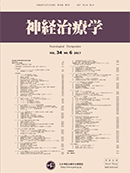40 巻, 3 号
選択された号の論文の88件中1~50を表示しています
-
2023 年 40 巻 3 号 p. 139-143
発行日: 2023年
公開日: 2023/08/21
PDF形式でダウンロード (439K)
第40回日本神経治療学会学術集会特集1
理事長講演
-
2023 年 40 巻 3 号 p. 145-146
発行日: 2023年
公開日: 2023/08/21
PDF形式でダウンロード (323K)
特別講演
-
2023 年 40 巻 3 号 p. 147-152
発行日: 2023年
公開日: 2023/08/21
PDF形式でダウンロード (2039K) -
2023 年 40 巻 3 号 p. 153
発行日: 2023年
公開日: 2023/08/21
PDF形式でダウンロード (44K) -
2023 年 40 巻 3 号 p. 154-159
発行日: 2023年
公開日: 2023/08/21
PDF形式でダウンロード (1863K)
特別企画シンポジウム1:地域医療部会シンポジウム
-
2023 年 40 巻 3 号 p. 160
発行日: 2023年
公開日: 2023/08/21
PDF形式でダウンロード (217K) -
2023 年 40 巻 3 号 p. 161-165
発行日: 2023年
公開日: 2023/08/21
PDF形式でダウンロード (2596K) -
2023 年 40 巻 3 号 p. 166-169
発行日: 2023年
公開日: 2023/08/21
PDF形式でダウンロード (962K) -
2023 年 40 巻 3 号 p. 170
発行日: 2023年
公開日: 2023/08/21
PDF形式でダウンロード (170K) -
2023 年 40 巻 3 号 p. 171
発行日: 2023年
公開日: 2023/08/21
PDF形式でダウンロード (188K)
特別企画シンポジウム2:創薬推進委員会シンポジウム
-
2023 年 40 巻 3 号 p. 172
発行日: 2023年
公開日: 2023/08/21
PDF形式でダウンロード (247K) -
2023 年 40 巻 3 号 p. 173-178
発行日: 2023年
公開日: 2023/08/21
PDF形式でダウンロード (504K) -
2023 年 40 巻 3 号 p. 179-183
発行日: 2023年
公開日: 2023/08/21
PDF形式でダウンロード (979K) -
2023 年 40 巻 3 号 p. 184-186
発行日: 2023年
公開日: 2023/08/21
PDF形式でダウンロード (348K) -
2023 年 40 巻 3 号 p. 187-191
発行日: 2023年
公開日: 2023/08/21
PDF形式でダウンロード (447K) -
2023 年 40 巻 3 号 p. 192-194
発行日: 2023年
公開日: 2023/08/21
PDF形式でダウンロード (356K)
教育講演
-
2023 年 40 巻 3 号 p. 195-199
発行日: 2023年
公開日: 2023/08/21
PDF形式でダウンロード (644K) -
2023 年 40 巻 3 号 p. 200
発行日: 2023年
公開日: 2023/08/21
PDF形式でダウンロード (195K) -
2023 年 40 巻 3 号 p. 201-204
発行日: 2023年
公開日: 2023/08/21
PDF形式でダウンロード (612K) -
2023 年 40 巻 3 号 p. 205-207
発行日: 2023年
公開日: 2023/08/21
PDF形式でダウンロード (378K) -
2023 年 40 巻 3 号 p. 208-213
発行日: 2023年
公開日: 2023/08/21
PDF形式でダウンロード (2138K) -
2023 年 40 巻 3 号 p. 214
発行日: 2023年
公開日: 2023/08/21
PDF形式でダウンロード (193K) -
2023 年 40 巻 3 号 p. 215
発行日: 2023年
公開日: 2023/08/21
PDF形式でダウンロード (177K) -
2023 年 40 巻 3 号 p. 216
発行日: 2023年
公開日: 2023/08/21
PDF形式でダウンロード (205K) -
2023 年 40 巻 3 号 p. 217
発行日: 2023年
公開日: 2023/08/21
PDF形式でダウンロード (136K) -
2023 年 40 巻 3 号 p. 218-222
発行日: 2023年
公開日: 2023/08/21
PDF形式でダウンロード (424K) -
2023 年 40 巻 3 号 p. 223
発行日: 2023年
公開日: 2023/08/21
PDF形式でダウンロード (201K)
マラソンレクチャー
-
2023 年 40 巻 3 号 p. 224
発行日: 2023年
公開日: 2023/08/21
PDF形式でダウンロード (185K) -
2023 年 40 巻 3 号 p. 225
発行日: 2023年
公開日: 2023/08/21
PDF形式でダウンロード (180K) -
2023 年 40 巻 3 号 p. 226
発行日: 2023年
公開日: 2023/08/21
PDF形式でダウンロード (153K) -
2023 年 40 巻 3 号 p. 227-231
発行日: 2023年
公開日: 2023/08/21
PDF形式でダウンロード (438K) -
2023 年 40 巻 3 号 p. 232
発行日: 2023年
公開日: 2023/08/21
PDF形式でダウンロード (188K) -
2023 年 40 巻 3 号 p. 233-236
発行日: 2023年
公開日: 2023/08/21
PDF形式でダウンロード (814K) -
2023 年 40 巻 3 号 p. 237-241
発行日: 2023年
公開日: 2023/08/21
PDF形式でダウンロード (631K)
メディカルスタッフ・レクチャー
-
2023 年 40 巻 3 号 p. 242
発行日: 2023年
公開日: 2023/08/21
PDF形式でダウンロード (158K) -
2023 年 40 巻 3 号 p. 243-248
発行日: 2023年
公開日: 2023/08/21
PDF形式でダウンロード (912K) -
2023 年 40 巻 3 号 p. 249-252
発行日: 2023年
公開日: 2023/08/21
PDF形式でダウンロード (443K) -
2023 年 40 巻 3 号 p. 253
発行日: 2023年
公開日: 2023/08/21
PDF形式でダウンロード (206K)
シンポジウム1:Parkinson症候群の治療法開発の最前線
-
2023 年 40 巻 3 号 p. 254
発行日: 2023年
公開日: 2023/08/21
PDF形式でダウンロード (302K) -
2023 年 40 巻 3 号 p. 255-258
発行日: 2023年
公開日: 2023/08/21
PDF形式でダウンロード (608K) -
2023 年 40 巻 3 号 p. 259-265
発行日: 2023年
公開日: 2023/08/21
PDF形式でダウンロード (529K) -
2023 年 40 巻 3 号 p. 266
発行日: 2023年
公開日: 2023/08/21
PDF形式でダウンロード (186K) -
2023 年 40 巻 3 号 p. 267
発行日: 2023年
公開日: 2023/08/21
PDF形式でダウンロード (206K)
シンポジウム2:脳梗塞治療の新たな門出
-
2023 年 40 巻 3 号 p. 268
発行日: 2023年
公開日: 2023/08/21
PDF形式でダウンロード (270K) -
2023 年 40 巻 3 号 p. 269-271
発行日: 2023年
公開日: 2023/08/21
PDF形式でダウンロード (409K) -
2023 年 40 巻 3 号 p. 272
発行日: 2023年
公開日: 2023/08/21
PDF形式でダウンロード (198K) -
2023 年 40 巻 3 号 p. 273
発行日: 2023年
公開日: 2023/08/21
PDF形式でダウンロード (221K) -
2023 年 40 巻 3 号 p. 274-277
発行日: 2023年
公開日: 2023/08/21
PDF形式でダウンロード (1077K)
シンポジウム3:NMOSDに対する生物学的製剤治療の現状と課題
-
2023 年 40 巻 3 号 p. 278
発行日: 2023年
公開日: 2023/08/21
PDF形式でダウンロード (260K) -
2023 年 40 巻 3 号 p. 279-282
発行日: 2023年
公開日: 2023/08/21
PDF形式でダウンロード (433K)
